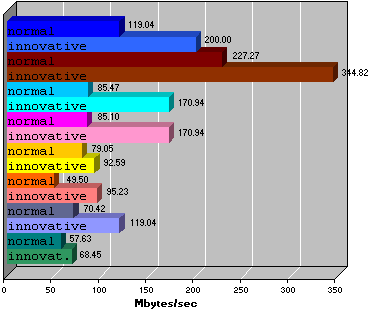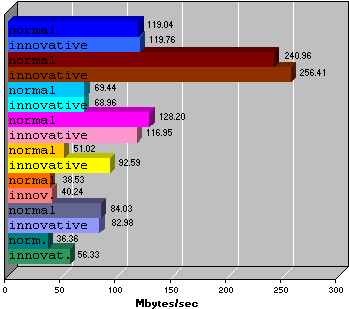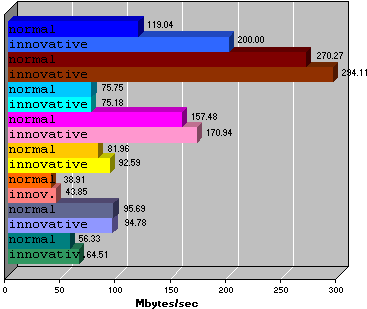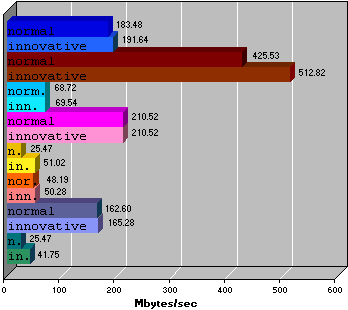

Chart guide:
The 'normal' rate is the rate which is achieved
with the best
normal way possible.
The 'innovative' rate is achieved by knowing
the performance flaw and applying our workarounds.
The source of these charts is Membench.
For more information click on any chart.
The performance flaw we are revealing in this site is affecting the
read and transfer rates not the write rates. Please click on the underlined
words in the following tables for more information.
I' Intel Pentium / Pentium MMX-200
MHz
Note: The plain non-MMX Pentium has almost identical results.
System configuration: Intel Pentium MMX-200 on
Intel's TX chipset with 64 Mb EDO memory, Matrox Mystique 4 MB graphics
card, Quantum Fireball 3.2 hard disk. All three socket 7 processors (Pentium
MMX, AMD K6, Cyrix 6x86MX) have been tested on exactly the same computer.
 |
 |
| Read | Write | Transfer | |
| memory | +68% | +100% | +92% |
| L2 cache | +51% | +100% | +69% |
| video | N/A | +17% | +19% |
System configuration: AMD K6-200 MHz (66*3) on
exactly the same system as the previous one.
 |
 |
| Read | Write | Transfer | |
| memory | +1% | -1% | +4% |
| L2 cache | +6% | -9% | -1% |
| video | N/A | +81% | +55% |
III' Cyrix 6x86MX (M2)-166 MHz
(PR200)
Note: Usually Cyrix processors carry the designation IBM. IBM just
manufactures them, Cyrix designs them; Cyrix is a fab-less chip vendor.
System configuration: Cyrix 6x86MX-166 MHz PR200
(66*2.5) on exactly the same system as the previous ones.
 |
 |
| Read | Write | Transfer | |
| memory | +69% | -1% | +13% |
| L2 cache | +9% | +9% | -1% |
| video | N/A | +13% | +15% |
IV' Intel Pentium II-233
MHz
System configuration: Intel Pentium II-233 on
Intel's FX chipset with 64 Mb EDO memory, Matrox Mystique 4 MB graphics
card, Quantum Fireball 3.2 hard disk.
 |
 |
| Read | Write | Transfer | |
| memory | +4% | +1% | +4% |
| L2 cache | +21% | +0% | +2% |
| video | N/A | +100% | +64% |
V' Cyrix 6x86 (M1)-133 MHz (PR166)
Values are similar to Cyrix M2 but with no write
allocation and no MMX. For detailed results look in Membench
(Cyrix M1 is one of the 8 computers you can compare your computer to).
So, If all workarounds where applied, a Cyrix 6x86-133 MHz would have:
| Read | Write | Transfer | |
| memory | +55% | +42% | +13% |
| L2 cache | +5% | +29% | -11% |
| video | N/A | +9% | +7% |
K5 is AMD's last generation processor. In contrast to M2 which is an
improved version of M1, K5 and K6 have nothing in common; K6 was derived
from Nextgen's 786. For detailed results look at
submitted results.
So, If all workarounds where applied, an AMD K5-100 MHz would have:
| Read | Write | Transfer | |
| memory | +29% | +35% | +3% |
| L2 cache | +23% | +97% | +34% |
| video | N/A | 0% | 0% |
We haven't been able to find one; if IDT sends
us one, we will provide detailed flaw analysis and a dedicated page at
the evaluation section of our site.
System configuration: Intel Pentium Pro-233 MHz (pushed)- 512k internal L2 cache, on a Gigabyte motherboard with Intel's FX chipset with 64 Mb 50 nSec EDO memory, Matrox Mystique 4 MB graphics card, Quantum Fireball 3.2 hard disk.
For remarks look at Pentium II (Pentium II
is essentially a Pentium Pro MMX with half speed cache).
For detailed results look in Membench
or at submitted results.
So, If all workarounds where applied, a Pentium II-233 would have:
| Read | Write | Transfer | |
| memory | +4% | +1% | +10% |
| L2 cache | +39% | +2% | +2% |
| video | N/A | +100% | +64% |
IX' Intel/AMD 486SX/DX/DX2/DX4/DX5
The same flaw exists also on 486 processors. But due to the different
burst length (16 bytes instead of 32), Membench's innovative measurements
are entirely incorrect.
Proceed to schematic
demonstration of the read buffer flaw.
Results
users submitted.
Click one of these buttons to go
to the evaluation section.
For questions, go to the Q&A
page.
For comments or suggestions, mail
us
Intel and Pentium are registered
trademarks of Intel corporation.
Other trademarks referenced in this site are owned by
their respective companies.
Everything at this web site is the property of Intelligent Firmware Ltd. You may not repost/publish this information without our explicit permission.